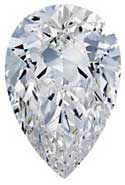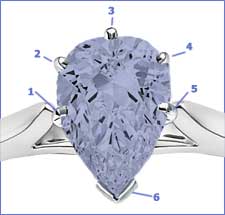 The pear shaped diamond is also called the "teardrop diamond" because of its shape.
The pear shaped diamond is a combination cut of the round-brilliant and the marquise (to see examples of these two
shapes, visit our diamond shapes page.
The pear shaped diamond is also called the "teardrop diamond" because of its shape.
The pear shaped diamond is a combination cut of the round-brilliant and the marquise (to see examples of these two
shapes, visit our diamond shapes page.
The
Pear Shaped Diamond is a fiery cut with lots of wonderful sparkle and flash.
The elegant lines of the Pear Shaped Diamond lends a sophisticated air to both the simplest and most elaborate ring settings.
Choosing a Pear Shaped Diamond
When purchasing a Pear Shaped Diamond, it's extremely important to pay
attention to quality and to select
the highest grade cut you can afford. Pear-shaped diamonds are prone
to two cutting issues: the bow-tie effect and "high" or "uneven"
shoulders.
 The image to the left is a simulation of the bow-tie effect. It's not
unusual to see "some" bow-tie if you examine a pear-shaped diamond from
various angles and in different lights, but what you don't want is an
obvious black/dark spot that is dull from every angle and in all lights.
If you're "wondering" if the diamond you purchased is suffering from
the bow-tie effect, it probably isn't. It's one of those defects, that,
when present
is obvious.
The image to the left is a simulation of the bow-tie effect. It's not
unusual to see "some" bow-tie if you examine a pear-shaped diamond from
various angles and in different lights, but what you don't want is an
obvious black/dark spot that is dull from every angle and in all lights.
If you're "wondering" if the diamond you purchased is suffering from
the bow-tie effect, it probably isn't. It's one of those defects, that,
when present
is obvious.
 The picture to the left is a simulation of "uneven shoulders". The
non-pointed end of the pear shaped diamond should have a nice round
and gentle arc. In addition to "uneven shoulders", sometimes cutters,
to increase the carat weight of the diamond "square off" or give a
"rounded
triangle" end to the pear-shaped diamond. High-shoulders and uneven
shoulders decrease the value of the diamond and should be avoided.
The picture to the left is a simulation of "uneven shoulders". The
non-pointed end of the pear shaped diamond should have a nice round
and gentle arc. In addition to "uneven shoulders", sometimes cutters,
to increase the carat weight of the diamond "square off" or give a
"rounded
triangle" end to the pear-shaped diamond. High-shoulders and uneven
shoulders decrease the value of the diamond and should be avoided.
The "good news" is that both of these potential problems are visible
to the naked eye. The "bad news" is that a diamond's certificate
will not likely provide enough information to discern either of these
problems when purchasing online. Which is why we
always recommend only purchasing diamonds online from a store with an excellent return policy or online photos of the diamond
you will purchase.
Our minimum recommendations for buying Pear Shaped Diamonds are as follows (please remember these
recommendations are opinion only, and your tastes may vary):
- Cut: Good
- Color: H
- Clarity: SI1
- Depth Percentage: 56-70%
- Table: 53-62%
- Length/Width Ratio: 1.45 - 1.70
Always be sure to check the length and width of the diamond prior to purchasing. The traditionally
accepted ratio for Pear Diamonds is 1.70:1 to 1.45:1, but some people prefer longer, thinner cuts, and some prefer
the shorter, fatter cuts.
Pear Shape Diamond Engagement Ring
While not the traditional shape selection, Pear Diamonds make lovely
engagement rings (either as a solitaire or with accent stones). It's
a beautiful cut with lots of sparkle and generally considered to carry
a more dramatic flair than the traditional round diamond.
That said, whenever choosing a non-traditional diamond shape, it is
always good to ensure that the recipient will be as enamored of the
shape as the giver.
How to Wear a Pear-Shaped Diamond Ring?
The most common question asked about pear shaped diamond rings is
"Which way should the diamond point face when wearing the ring?"
Meaning "should the point of the teardrop face the wearer's
fingernails or wrist?"
The best answer? Wear the ring the way you prefer, there is no
standard (or even strong tradition) for the "point" direction, and no
right or wrong answer.
Many wearers feel that wearing the ring pointed toward the fingernails
provides a slimming look for the fingers.
 Pear Diamonds require specialized settings — particularly with an added prong to protect the point of the diamond.
Pear Diamonds require specialized settings — particularly with an added prong to protect the point of the diamond.
The example here shows a six prong setting. Five prongs support the
bulk of the diamond and the sixth prong supports and protects
the fragile point.
Hand-Selected Pear Shaped Diamonds
 To give you some ideas of what's available for a Pear Diamond ring,
we've preselected a range of certified Pear Diamonds for you to
examine. Except for the "Bargain Basement" selections, these diamonds are within
our minimum requirements as listed above and are suitable for solitaire settings or settings with accent stones.
To give you some ideas of what's available for a Pear Diamond ring,
we've preselected a range of certified Pear Diamonds for you to
examine. Except for the "Bargain Basement" selections, these diamonds are within
our minimum requirements as listed above and are suitable for solitaire settings or settings with accent stones.
No comments:
Post a Comment